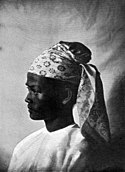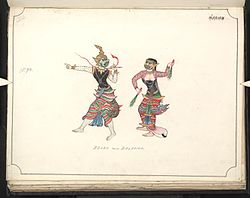Chief Queen's Apartments, Mandalay Palace
Photograph of the Chief Queen’s apartments in the Nandaw (Royal Palace) at Mandalay in Burma (Myanmar), from the Archaeological Survey of India Collections: Burma Circle, 1903-07.
- The photograph was taken by an unknown photographer in 1905 under the direction of Taw Sein Ko, the Superintendent of the Archaeological Survey of Burma at the time. This is a view of the wooden pavilions occupied by the Chief Queen of the Burmese monarchy.
- The last queen to occupy them was Supayalat, royal consort of Thibaw (reigned 1878-1885) the last king of Burma. They were exiled to India when Thibaw formally surrendered to the British in 1885 following the Third Burmese War, which culminated in the annexation of Upper Burma. The apartments were situated in the heart of the Royal Palace next to the Glass Palace, occupied by the King, in the middle of a sequence of state rooms leading from the Great Hall of Audience on the east face of the palace, which faced the main city gate of Mandalay, towards the more private women’s apartments occupied by queens of various rank at the western end. This arrangement followed the Burmese tradition of building palaces on an east-west axis. The pavilion is crowned with a tiered roof, a symbolic form demarcating sacred space which was restricted to royal and religious architecture. The Royal Palace stood at the centre of Mandalay, a walled city founded in 1857 which became Burma’s last great royal capital. It was one of the first buildings to be constructed, re-using many parts of the teak buildings from the former capital Amarapura. The original palace was destroyed by fire during Allied bombing raids in 1945 during the Second World War but has since been partially reconstructed.
Relevante Bilder
Relevante Artikel
Yoke théYoke thé, auch yokthe thay ist der birmanische Name für das Marionettentheater in Myanmar. Die im 19. Jahrhundert üblichen 28 bemalten und mit einem Kostüm bekleideten Holzpuppen hingen an bis zu 18 Fäden und wurden von einem Puppenspieler bedient. Ein Set bestand aus mythologischen Figuren, Tier- und Menschenfiguren. Die führende Rolle im Ensemble kam dem Sänger und Sprecher einer der beiden Hauptfiguren zu. Das in Südostasien einzige traditionelle Marionettentheater ist seit dem 15. Jahrhundert nachweisbar, es erlebte seinen Höhepunkt während der Konbaung-Dynastie (1752–1885), als es vom Königshaus kontrolliert, gefördert und gegenüber den Tanztheatern mit Schauspielern bevorzugt wurde. Eine nächtliche Vorstellung begann stets mit der durch das Begleitorchester hsaing waing akustisch symbolisierten Erschaffung der Welt, gefolgt von einer Szene im Wald Himawunta und danach einer Szene im Palast, die symbolisch der Einführung des Königtums entsprach. Um Mitternacht folgte das eigentliche Schauspiel, das häufig buddhistische Jataka-Erzählungen darstellte. .. weiterlesen
















